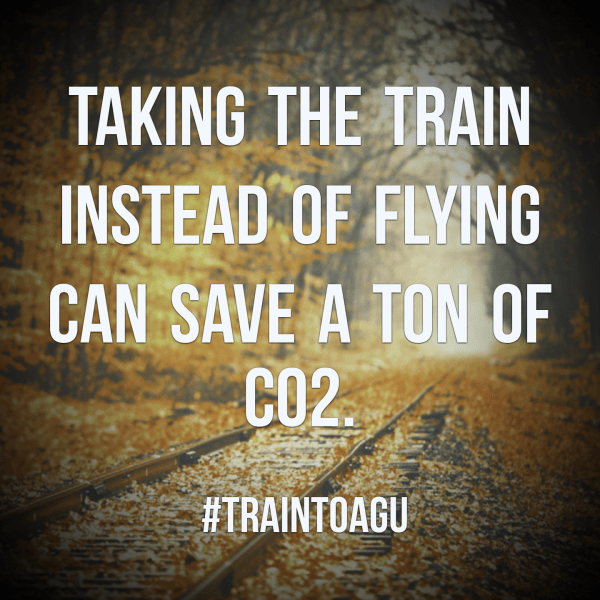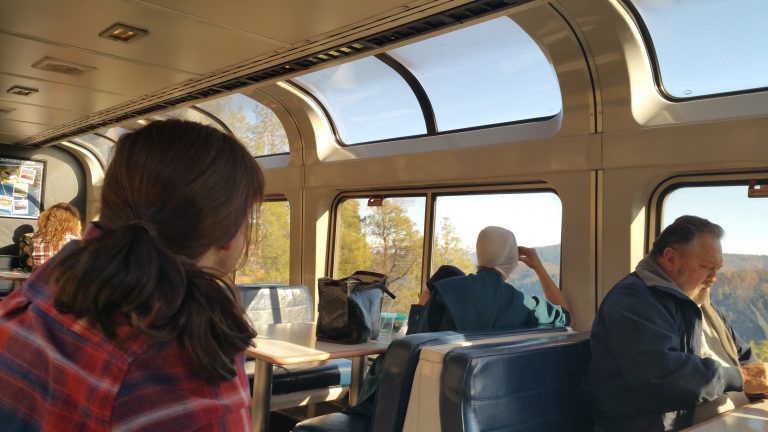

By Anna Scott
Want to save the planet? Are you, like me, a young professional struggling to reduce your carbon footprint? Then join me in taking the train to your next professional conference.
Most of my low-carbon lifestyle is admittedly enforced on me by my student budget. I have no kids, bicycle to work and share a house with roommates. What dominates my carbon footprint is the flights I take—I’ll be hitting frequent flyer status this year thanks to traveling for conferences, talks and workshops (not to mention those flights to see my family during the holidays—even being unmarried doesn’t get me out of visiting in-laws overseas). This is a bittersweet moment for a climate scientist—my professional success gives me an opportunity to impact the world with my science, but is hurting the planet and leaving future generations with a mess that will outlive me.
There’s no silver bullet to fixing climate change, but I think scientists and science enthusiasts can start with ourselves.
Every year, together with 25,000 of my closest climate and Earth science buddies, I attend the American Geophysical Union meeting. (You may have heard about it last year on NPR).
Prof. Lawrence Plug calculated that the 2003 meeting generated more than 12,000 tons of CO2. Since then, the meeting has more than doubled in size, suggesting that the carbon footprint is upwards of 25,000 tons of CO2 from flights alone.

Prominent scientists like Katherine Hayhoe have suggested that we shift to teleconferencing instead. I think this is great for small meetings of folks who already know each other, or for prominent scientists like Dr. Hayhoe, who have an established publication record and name recognition.
For the little folks like myself though, meetings offer tremendous opportunities to connect with colleagues at other institutions, meet potential collaborators, and scout new job opportunities. The “serendipitous interaction” that meetings allow is similar to the design principles that tech firms like Google enact when designing their public spaces. This fall alone, I’ve filled a shoebox with business cards from colleagues working on similar problems, potential collaborators working in similar fields, and, most lucratively, established scientists who have news of post-doctoral fellowships and job opportunities.
This last point may be especially critical for minority scientists, who may lack the social networks needed to get jobs.
In short, I’m not switching to virtual anytime soon, mostly because I can’t see it paying off (yet—Katherine Hayhoe et al, if you’re reading this, hire me!). But I still need to reduce my carbon footprint.
My solution? Replace one conference travel flight with a train ride. Repeat every year. Last year, I took Amtrak’s California Zephyr from San Francisco to Chicago back from AGU’s fall meeting and crossed the Rockies next to a geophysicist explaining plate tectonics and identifying rocks.
The year before, I returned from New Orleans and wrote my thesis proposal while rolling through bayous, swamps and pine forests of the Southeast.

(Don’t think you have time for this? I spent the trip writing a paper, now published in PLOS-ONE. Amtrak seats all come with electrical outlets and seatback trays that function terrificly as desks).
Is this a practical solution for everybody? Nope, and I won’t pretend that it is. Your time might be better spent with your kids, or volunteering in your community, or maybe you want to drive instead- I don’t know your life. Train infrastructure is lacking in the U.S., and delays are common as Amtrak doesn’t own the tracks and must give way to commercial freight. But I maintain my hope that increased demand for train travel can spur future investment, sending a market signal that young people want to travel this way.
This year, I’ll be taking the train to AGU’s fall meeting in New Orleans from Washington DC.
I estimate that I’ll be saving about one ton of CO2 equivalent (calculation included radiative forcing). If you’re headed that way, I invite you to join me, tell your friends or even just reflect on the possibility that low carbon alternatives to flying exist. We can’t fix everything. But if we all do our little part, we can accomplish something. And something is always better than nothing.
Anna Scott is a PhD student in the Earth and Planetary Science Department at the Krieger School of Arts and Sciences at Johns Hopkins.

 233k
233k  41k
41k  Subscribe
Subscribe 